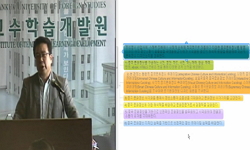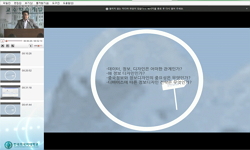본 연구는 도서관의 문헌 위치 정보를 효율적으로 인지하기 위한 정보 디자인 개발에 목적을 두고 있다. 도서관 이용자가 문헌 위치를 찾기 위해 정보를 이용하는 과정을 살펴보면 일반적...
http://chineseinput.net/에서 pinyin(병음)방식으로 중국어를 변환할 수 있습니다.
변환된 중국어를 복사하여 사용하시면 됩니다.
- 中文 을 입력하시려면 zhongwen을 입력하시고 space를누르시면됩니다.
- 北京 을 입력하시려면 beijing을 입력하시고 space를 누르시면 됩니다.
https://www.riss.kr/link?id=T11747599
- 저자
-
발행사항
수원: 경기대학교, 2009
-
학위논문사항
학위논문(석사) -- 경기대학교 미술·디자인대학원 (수원) , 디자인-시각정보디자인전공 , 2009
-
발행연도
2009
-
작성언어
한국어
- 주제어
-
발행국(도시)
경기도
-
기타서명
A study on information visualization in library literature location
-
형태사항
vii, 76 p.: 삽도; 26 cm.
-
일반주기명
경기대학교 논문은 저작권에 의해 보호받습니다.
지도교수 : 강윤성
참고문헌 : p.71-73 - 소장기관
-
0
상세조회 -
0
다운로드
부가정보
국문 초록 (Abstract)
본 연구는 도서관의 문헌 위치 정보를 효율적으로 인지하기 위한 정보 디자인 개발에 목적을 두고 있다.
도서관 이용자가 문헌 위치를 찾기 위해 정보를 이용하는 과정을 살펴보면 일반적으로 웹 또는 키오스크와 같은 설치물로 검색을 하여 청구기호를 얻는다. 이 청구기호는 각각의 문헌마다 갖고 있는 고유번호로써 이를 통해 서가 배치도, 사인, 라벨 등의 여러 시각 정보물을 통하여 위치를 찾게 된다. 이 과정에서 이용자가 접하는 정보에 대한 커뮤니케이션이 효율적으로 이루어져 있는가를 살펴보고 문헌 위치 정보 시각화의 문제점을 찾아 그 개선안을 제시하고자 한다.
정보 디자인에 대한 개념을 바탕으로 도서관의 환경과 시각 정보물을 분석한 결과 다음과 같은 내용을 알 수 있었다.
첫째, 도서관의 정보들은 이용자에게 적절한 시간 안에 필요한 정보를 제공하기 위하여 일정한 기준과 순서로 배열되고 있다. 이들 기준에 가장 대표적인 것으로 문헌분류체계를 들 수 있다. 이 문헌분류체계의 목적은 방대한 양의 문헌에서 관련성 있는 문헌을 선별하여 한 곳에 모아둠으로써 이용자는 관련 주제를 손쉽게 검색할 수 있고, 도서관 측면에서는 정보검색과 정보서비스를 보다 신속하게 할 수 있다.
둘째, 문헌 위치 정보는 다양한 매체를 통해서 제공 되고 있다. 문헌의 정보를 검색하기 위한 디지털매체, 위치의 방향을 유도하고 기명하는 사인물, 그 외에 도서관 안내를 위한 여러 인쇄물 등의 매체를 접할 수 있다. 이들은 상호적으로 위치의 접근을 돕고 있으므로 이용자 시선에서 일관되게 보여야 정보에 대한 이해를 높일 수 있다고 할 수 있다.
본 연구를 위해 국가대표 도서관인 국립중앙도서관을, 최근에 개관한 국내의 연세대학교 학술정보원과 숙명여자대학교 중앙도서관을, 국외 사례로는 미국 산호세주립대학교 마틴루터(DR. Martin Luther King, JP. Library)도서관을 선정하여 사례 분석하였다.
문헌 위치에 대한 정보를 갖고 있는 공간안내도와 검색시스템, 서가사인을 중점적으로 분석한 결과, 국립중앙도서관에서는 서가사인에 분류항목명을 기재함으로써 이용자의 문헌탐색을 도왔고, 연세대학교 학술정보원의 검색 시스템에서는 청구기호 검색결과를 그래픽으로 시각화하여 보여줌으로써 문헌 위치에 대한 이해를 높였다. 숙명여자대학교 중앙도서관의 서가사인은 서가의 일련번호 아이덴티티와 색채분류를 통해 쉽게 인지할 수 있도록 구성되어 있었으며 산호세주립대학교 마틴루터도서관의 공간안내도에서는 서가의 시작점과 배열된 순서를 쉽게 인지할 수 있도록 배려된 점을 확인할 수 있었다.
하지만 도서관 이용자들은 도서관 이용목적이 모두 다르고 문헌을 찾는 방법이 다양하여 한 가지 시각 정보물에만 의존할 수 없으며, 정보탐색의 시작점 또한 불특정하다. 때문에 다양한 측면에서 접근하는 가능성을 고려하여 정보 디자인이 계획되어야 할 필요가 있는데 위의 사례에서는 각 매체마다 시각적 표현이 다르고 통일성이 없어 커뮤니케이션을 어렵게 하고 있었다.
따라서 웹, 공간, 서가에 적용된 문헌 위치 정보의 수월성과 이용자들의 효율적 인지를 위한 정보의 시각화, 즉 도서관 문헌 위치 정보 디자인이 요구된다. 이를 위하여 국립중앙도서관을 대상으로 다음과 같은 방안이 적용된 디자인을 제안하였다.
첫째, 문헌 위치 정보 디자인의 아이덴티티와, 문헌분류체계를 시각화하기 위한 색채 시스템을 구축한다. 둘째, 통일된 시각적 표현으로 일관성을 지녀야 하며 상호 연계된 호환성을 가져야 한다. 셋째, 도서관 이용자가 다양한 측면에서 문헌 탐색이 가능하도록 한다.
이와 같은 시각적 체계화를 통해 도서관이 보다 편리하고 친근하며, 문화적 욕구를 충족시켜 주는 역할을 하는 공간으로 발전하기 위한 기초적 자료를 제시하는데 본 연구의 의의를 두고자 한다.
다국어 초록 (Multilingual Abstract)
This study intends on information design development to recognize efficiently information in library literature location. If we look through searching process when finding the literature location, generally speaking, we obtain the call number from the...
This study intends on information design development to recognize efficiently information in library literature location. If we look through searching process when finding the literature location, generally speaking, we obtain the call number from the web or kiosks. This call number is an identification number on each literature, and we’re able to find the literature location from several visual signs – bookshelves map, index number, and each book label, etc. In this process, after seeing how an efficient communication is delivered to the users, I’d like to present the better way to provide an efficient communication, solving several problems. Consequently, after analyzing the library’s environment and visual media, several results are found based on the concept of information design.
First, in the library, to provide proper information to the users within a certain amount of time, all the information is well-arranged and put everything in order. One of representative examples is the literature classification system. The purpose of the literature classification system is to sort out related literature from the vast quantities of literature by storing them ina space, so the users are able to search the related topics easily, in addition, the library can provide a better and faster information searching service to the users.
Second, the literature location system has been provided by various media: a digital media to search the literature information, a signage system to direct and display information, and several print media to be used as library catalogs. These media increase the accessibility each other, and the understanding of information can be increased if it is displayed consistently to the users.
For this case study, I selected and analyzed the National Library of Korea, and two libraries that were just opened recently, Yeonsei University Library and Sookmyung Women’s University Library, and one library in California, U.S., San José State University Library, called Martin Luther King, Jr. Library.
After thoroughly comparing and analyzing each library based on space map, searching system, and index number, in the National Library of Korea, a classified item was included on each index number, so that it was very helpful for the users when they searched the literature. In Yeonsei University Library, searching system helped the users increase the understanding of the literature location, by showing the result of call number visually with graphics. In Sookmyung Women’s University Library, the index number was well-displayed to be recognized easily, by bookshelves’ identity number and color classification, and in Martin Luther King, Jr. Library (MLK Library), the space map on each floor helped the users recognize easily the starting point and arranged order of the bookshelves.
However, since all users have different purposes to visit the library and their searching method is various as well, the users cannot relyon only one visual medium, and the staring point to search information is also unspecified. In this case, information design is necessary to be planned with considering the possible accessibility, but in these examples, since each medium has different visual representations with inconsistency, the better communication is not occurred.
Therefore, information visualization – for easiness of information and the users’ efficient recognition on the web, space, and bookshelves – in other words, information design for the literature location is required. For this case, with an exemplification of the National Library of Korea, I propose several design examples as below;
First, a color system should be constructed to visualize design identity for information design of the literature location and the literature classification system. Second, it should be consistent with unified visual representations and compatibilities. Third, the users should be able to search the literature with various accessibilities.
Through visual systematization, I have made a significant contribution to this case study, suggesting a fundamental material that the library, as a more convenient and friendly space, meets the cultural desire.
목차 (Table of Contents)
- 표목차 Ⅲ
- 그림목차 Ⅳ
- 논문개요 Ⅵ
- 1. 서론 01
- 1.1 연구의 목적 01
- 표목차 Ⅲ
- 그림목차 Ⅳ
- 논문개요 Ⅵ
- 1. 서론 01
- 1.1 연구의 목적 01
- 1.2 연구내용 및 방법 02
- 2. 정보 디자인의 이론적 고찰 04
- 2.1 정보 디자인의 개념 및 정의 04
- 2.2 정보 디자인의 원리 06
- 2.2.1 정보의 조직화 07
- 2.2.2 정보의 시각화 09
- 2.2.3 정보의 시각화와 지각 심리 11
- 2.3 위치 안내를 위한 정보 디자인 13
- 3. 도서관 문헌 위치 정보의 시각화에 관한 고찰 15
- 3.1 문헌 위치 정보를 위한 시각 정보물의 기능 15
- 3.2 문헌 위치 정보의 디자인 요소 18
- 3.3 문헌 위치 정보의 전달 매체 및 특성 25
- 3.3.1 사인 시스템 25
- 3.3.2 디지털 매체 27
- 3.4 문헌 위치 정보 탐색에 영향을 미치는 요소 30
- 3.4.1 도서관 문헌분류체계 30
- 3.4.2 도서관 이용자의 동선 34
- 3.4.3 효율적인 정보전달을 위한 요소 36
- 4. 도서관 문헌 위치 정보 디자인 연구방법 및 사례분석 39
- 4.1 도서관 문헌 위치 정보 디자인 연구방법 39
- 4.2 도서관 문헌 위치 정보 디자인 사례분석 41
- 4.2.1 국립중앙도서관 41
- 4.2.2 연세대학교 학술정보원 45
- 4.2.3 숙명여자대학교 중앙도서관 49
- 4.2.4 산호세주립대학교 마틴루터도서관 52
- 4.3 문제점 및 개선 방안 56
- 5. 도서관 문헌 위치 정보 디자인 연구 및 개발 58
- 5.1 디자인 범위 58
- 5.2 디자인 목표 58
- 5.3 디자인 개발 59
- 5.4 디자인 제안 62
- 5.4.1 공간안내도 65
- 5.4.2 검색 위치 안내도 66
- 5.4.3 서가사인 67
- 6. 결론 68
- 참고문헌 71
- Abstract 74












